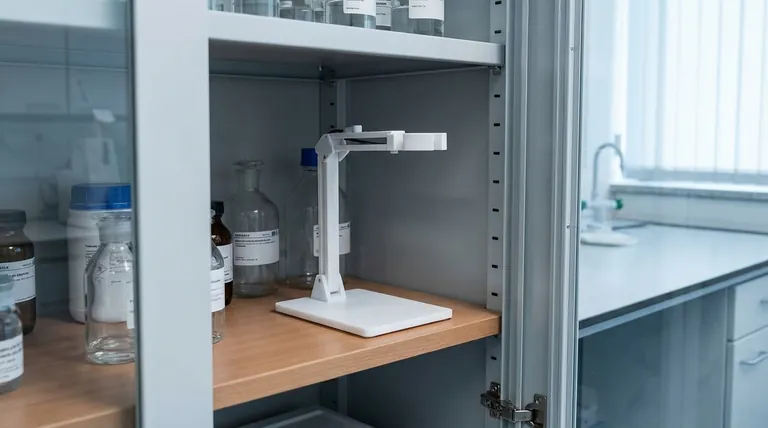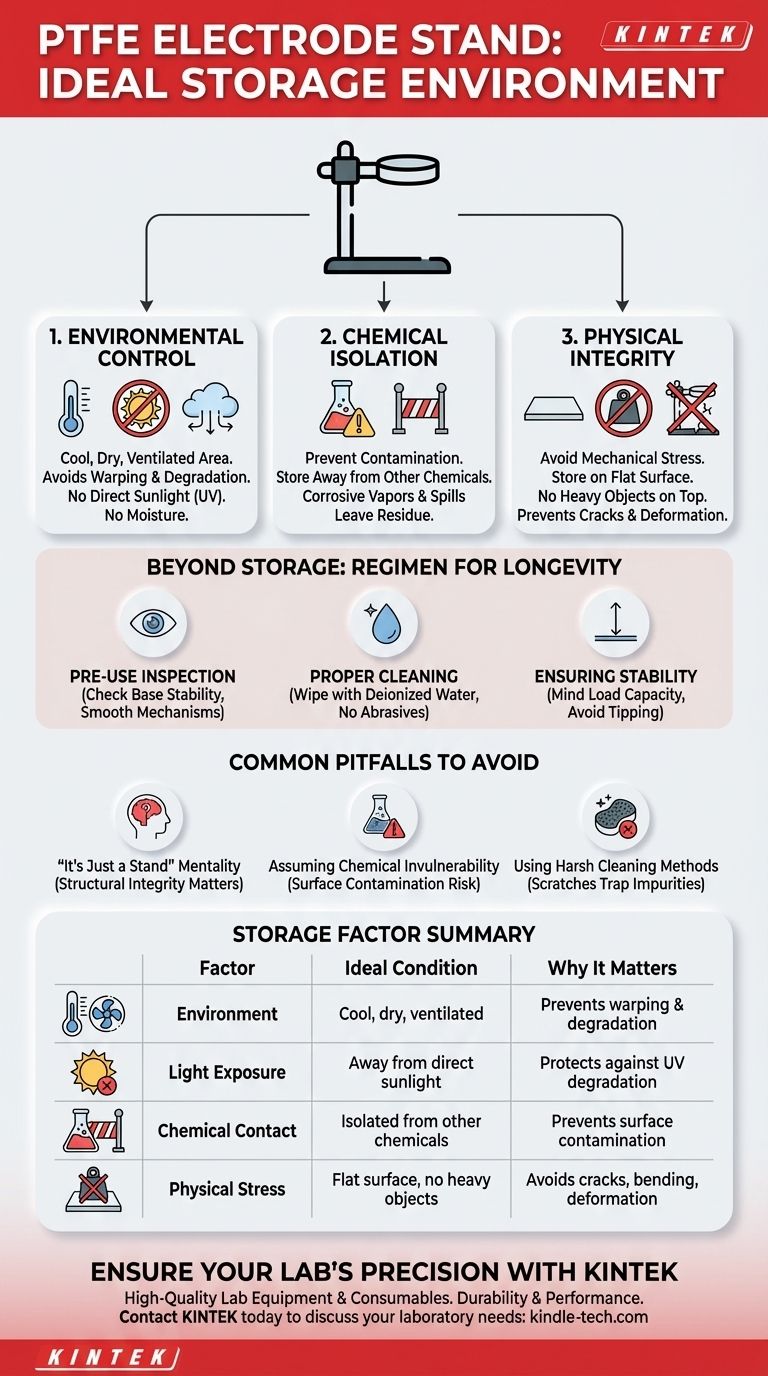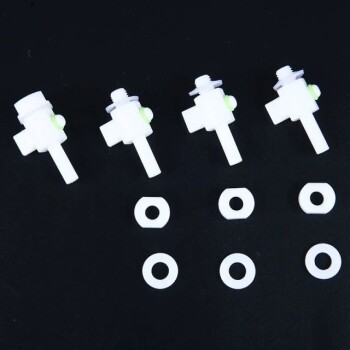To properly store a PTFE electrode stand, you must place it in a dry, ventilated, and cool environment. It is critical to keep the stand away from direct sunlight, high-temperature sources, and any contact with other chemicals to prevent physical degradation and surface contamination.
The core objective of proper storage is not just to put the stand away, but to preserve its two most critical properties: its chemical inertness and its physical stability. Failing to do so can compromise experimental integrity and operational safety.

The Core Principles of PTFE Storage
Proper storage is a preventive measure. It protects the stand from subtle environmental factors that can cause damage over time, ensuring it remains a reliable and safe tool for your experiments.
Environmental Control: Temperature and Light
A controlled environment is the first line of defense. Store the stand in a cool, dry, and ventilated area like a dedicated lab cabinet.
High temperatures can cause the PTFE material to warp or deform, compromising the stability of your entire electrochemical cell. Direct sunlight (UV radiation) can also degrade materials over long periods, while moisture can introduce contaminants.
Chemical Isolation: Preventing Contamination
You must store the stand so it does not come into physical contact with other laboratory chemicals.
Although PTFE is famously non-reactive, corrosive vapors or accidental spills can leave residue on the surface. This residue can later leach into your electrolyte, contaminating your experiment and invalidating your results.
Physical Integrity: Avoiding Mechanical Stress
Store the stand on a flat surface without placing heavy objects on top of it.
PTFE is a relatively soft material. Continuous mechanical stress from improper storage can lead to cracks, bending, or deformation, which might not be visible at a glance but can cause instability when the stand is loaded with a heavy electrolytic cell.
Beyond Storage: A Regimen for Longevity
A comprehensive care strategy extends beyond simple storage. Integrating inspection and cleaning into your workflow ensures the stand is always ready for use.
Pre-Use Inspection
Before every use, perform a quick physical check. Verify that the base is stable and free of any cracks or visible deformation.
Ensure that all lifting supports and adjustment knobs function smoothly. If a mechanism is stuck, clean it of any debris before applying a minimal amount of appropriate lubricant.
Proper Cleaning Protocol
The correct cleaning method is to gently wipe the surfaces with deionized water or a suitable solvent.
It is absolutely prohibited to use abrasive tools like steel wool or scouring pads for cleaning. These will create micro-scratches on the PTFE surface, which can trap contaminants and compromise future experiments.
Ensuring Stability in Use
Always be mindful of the stand's load capacity. When using large or heavy electrolytic cells, confirm that the stand is rated to support the total weight of the cell plus the electrolyte to prevent tipping and ensure safety.
Common Pitfalls to Avoid
Mistakes in handling support equipment are common but easily preventable. Understanding these pitfalls is key to maintaining a safe and efficient lab environment.
The "It's Just a Stand" Mentality
The most common mistake is treating the electrode stand as an afterthought. Its structural integrity is foundational to the safety of your setup and the precision of your measurements. A compromised stand can lead to spills, broken equipment, and ruined experiments.
Assuming Complete Chemical Invulnerability
While PTFE is exceptionally resistant, it is not a license for careless handling. The primary risk is not a reaction with the PTFE, but surface contamination. Proper storage and cleaning protocols are designed to prevent foreign substances from being introduced into your experiments.
Using Harsh Cleaning Methods
Never use abrasive materials or sharp tools for cleaning. The physical softness of PTFE means it is easily scratched. These scratches not only damage the stand but also create sites where chemical impurities can accumulate.
A Practical Checklist for Your Lab
Use these guidelines to align your maintenance practices with your primary laboratory goals.
- If your primary focus is maximizing equipment lifespan: Store the stand away from heat, direct sunlight, and physical stress to prevent warping and material degradation.
- If your primary focus is ensuring experimental purity: Prioritize chemical isolation during storage and a strict cleaning protocol using deionized water after every use.
- If your primary focus is maintaining operational safety: Implement a mandatory pre-use inspection to check for cracks, ensure the base is stable, and confirm that the stand's load capacity is sufficient for your cell.
Proper care for foundational equipment like your electrode stand is a direct investment in the reliability and safety of your scientific outcomes.
Summary Table:
| Storage Factor | Ideal Condition | Why It Matters |
|---|---|---|
| Environment | Cool, dry, ventilated area | Prevents warping and material degradation |
| Light Exposure | Away from direct sunlight | Protects against UV degradation |
| Chemical Contact | Isolated from other chemicals | Prevents surface contamination |
| Physical Stress | Stored on a flat surface, no heavy objects on top | Avoids cracks, bending, and deformation |
Ensure Your Lab's Precision with KINTEK
Your PTFE electrode stand is a critical piece of equipment that demands proper care to maintain the integrity of your experiments. The right storage and handling are investments in reliable, safe, and accurate scientific outcomes.
KINTEK specializes in high-quality lab equipment and consumables, designed for durability and performance. We understand the needs of laboratories that rely on precision instruments like PTFE electrode stands.
Let us help you protect your investment and enhance your lab's efficiency. Our experts can provide guidance on the best equipment and maintenance practices for your specific application.
Contact KINTEK today to discuss your laboratory needs and discover how our solutions can support your research goals.
Visual Guide

Related Products
- Platinum Auxiliary Electrode for Laboratory Use
- Custom PTFE Teflon Parts Manufacturer PTFE Beaker and Lids
- PTFE Electrolytic Cell Electrochemical Cell Corrosion-Resistant Sealed and Non-Sealed
- Custom PTFE Teflon Parts Manufacturer for PTFE Mesh F4 Sieve
- Custom PTFE Teflon Parts Manufacturer for Air Valve Applications
People Also Ask
- How should a platinum wire/rod electrode be cleaned after use? A Guide to Maintaining Optimal Performance
- Why is it important to avoid collisions with a platinum disk electrode? Protect Your Data Integrity and Accuracy
- What are the specifications of the Platinum-Titanium Functional Electrode? Maximize Electrochemical Performance
- How should a platinum wire electrode be handled? Ensure Accurate Measurements and Longevity
- What are the standard specifications for platinum wire and rod electrodes? Select the Right Form Factor for Your Experiment



















